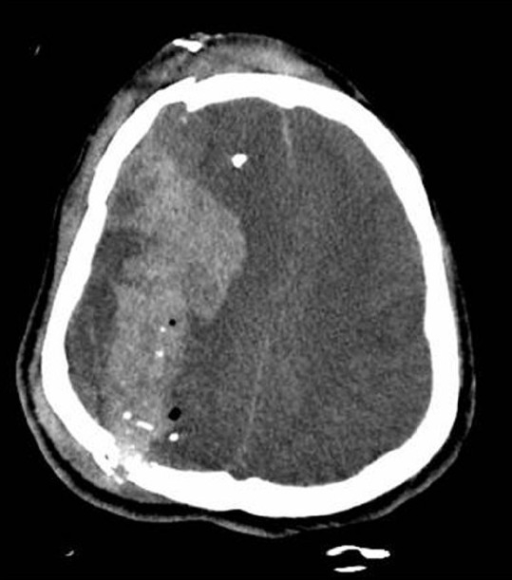Playlist
Show Playlist
Hide Playlist
Herniation and Injuries
-
Slides Intracranial Hemorrhage.pdf
-
Download Lecture Overview
00:01 So what exactly is herniation? Herniation is when a portion of the brain displaces from one compartment to another and it's caused by adjacent mass effect. 00:09 This can actually result in death so it's important to recognize this finding. 00:13 Subfalcine herniation occurs when the brain parenchyma and lateral ventricle are displaced under the falx and cross the midline. 00:21 Transtentorial herniation occurs when the temporal lobe displaces downward through the tentorium and then tonsillar herniation occurs when the cerebellum displaces downward through the foramen magnum. 00:34 So let's talk a little bit about coup and contracoup injuries. 00:38 A coup injury occurs at the point of impact when a patient has a traumatic injury. 00:42 This can result in hemorrhage due to shearing of the blood vessels. 00:46 A contracoup injury is injury that occurs at the side opposite the side of impact and this can result in hemorrhage due to impact of the brain parenchyma against the skull. This can occur together or they can occur alone. 00:59 Diffuse axonal injury is another type of injury that's caused by trauma. 01:03 It's caused by acceleration/deceleration which can result in stretching of the axons. 01:08 This can be hemorrhagic or it can be non-hemorrhagic and the hemorrhagic one actually results in multiple small microbleeds. 01:16 This has a very poor prognosis. 01:19 This can actually be very difficult to see on CT so MRI is the study of choice when a DAI is suspected. You can see multiple punctuate dark areas on iron specific sequences that are T1 and T2 bright. 01:32 You can often see microhemorrhages that are found within the corpus callosum. 01:36 So let's take a look at this case. 01:39 What do you think this represents? This is a type of hemorrhage. 01:44 What kind of hemorrhage is this and how would you describe it? This is an intracerebral hematoma. 01:56 We have a left frontal and temporal hematoma that has surrounding vasogenic edema which you can see here, the areas of low density. 02:06 There's actually been a craniotomy right here to relieve the pressure within the brain. 02:12 There still is persistent, mild, subfalcine herniation or midline shift to the right. 02:18 So in this lecture we've gone over some common causes of brain hemorrhage and we've learned how to differentiate between the different types of hemorrhage that you might encounter.
About the Lecture
The lecture Herniation and Injuries by Hetal Verma, MD is from the course Neuroradiology.
Included Quiz Questions
Which of the following statements is correct about diffuse axonal injury?
- It may be hemorrhagic or non-hemorrhagic.
- It results in hemorrhage at the point of impact.
- It results in hemorrhage opposite the side of impact.
- It has a good prognosis if diagnosed quickly.
- It is best seen on CT.
In which type of brain herniation does the cerebellum displace downward through the foramen magnum?
- Tonsillar
- Subfalcine
- Transtentorial
- Basal
- Mixed
Which of the following regarding coup and contrecoup injuries is NOT true?
- Contrecoup injury results in hemorrhage due to shearing of the blood vessels.
- They can occur together or alone.
- Contrecoup injury occurs on the side opposite the impact.
- Coup occurs due to injury at the point of impact.
- Contrecoup results from the impact of the brain parenchyma against the skull.
Customer reviews
5,0 of 5 stars
| 5 Stars |
|
5 |
| 4 Stars |
|
0 |
| 3 Stars |
|
0 |
| 2 Stars |
|
0 |
| 1 Star |
|
0 |




